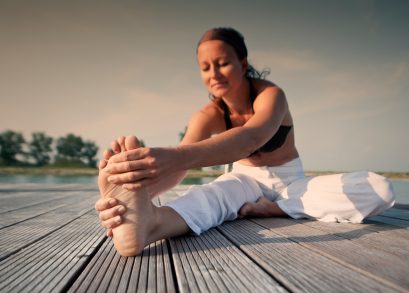How to be more flexible
Yes, you can increase your flexibility’it just takes a little time and some targeted stretching. Here’s how to do it right

Source: Web exclusive: November 2011
Flexibility is probably the most neglected of the fitness triumvirate. Cardio burns calories and strength training builds muscle, but stretching? Even though we know its benefits, it’s all too easy to do a few token post-workout moves and then sprint for the shower, or hit a yoga class every week or two and think that’s all the body needs.
But stretching is more important than most of us think, says Nikos Apostolopoulos, director of the Microstretching Clinic in Vancouver. ‘Movement is what is closest to the soul,’ he says, quoting Aristotle. ‘If we’re unable to move pain free, it affects us mentally and physically.’
What makes a person flexible?
‘The first thing that determines flexibility is joint structure,’ Apostolopoulos says, and that’s something we can’t do much about. Some of us are just born with greater range of motion in the joints’think of a ballet dancer who can go farther than 180 degrees in the splits. Mere mortals can’t compete with that, and shouldn’t try to.
Ligaments, which join bone to bone, and tendons, which connect muscle to bone, also have much to do with innate flexibility. ‘Some people are born with looser ligaments, which means they have more ability to move through the joints,’ Apostolopoulos explains.
The true range of motion most of us have to work with is in muscle, which Apostolopoulos says can stretch up to one-and-a-half times its length. By working on muscle, we can increase flexibility and increase range of motion.
Age doesn’t (really) matter
Yes, age affects your flexibility”after the age of 35 your tendons start crystallizing,’ says Apostolopoulos. ‘It’s harder to increase your range of motion naturally.’ But by no means does that mean you should throw in the towel, he adds. ‘You can increase your flexibility well into your 80s.’
Stretch long, stretch often
To get more flexible, Apostolopoulos recommends stretching each muscle group daily for 60 seconds at a time, three times per muscle group. For instance, you might stretch your left hamstring for 60 seconds, then your right, then repeat two more times. But be gentle, he warns: ’60 seconds of a gentle stretch, not a hard stretch.’
Find the right position
‘Most people don’t put their bodies in a proper position that will facilitate the ability to relax the nervous system,’ says Apostolopoulos’and the greatest flexibility gains are made when the body and mind are relaxed. To that end, he recommends finding a stable position that will allow the whole body to relax (this generally means reclining on the ground’see examples of various stretches on his website) and aiming for proper body position in each stretch”square hips, square shoulders and your feet have to be shoulder width apart.’
Timing is key
Not only shouldn’t you do static stretching before exercise, Apostolopoulos says, but’contrary to what many trainers recommend’you should avoid it after exercise when muscles are warm, because warm muscles and tendons, he says, will stretch too far. Try for yourself and see which method works for you in terms of relieving tightness and promoting flexibility. Two or more hours after activity, he adds, ‘your muscles are cold and you know how far you can go.’ Better yet, try gentle stretching before bed. Done properly, stretching will help relax the nervous system, meaning you’ll sleep better’and better sleep means better muscle recovery, too.
No pain, all gain
Apostolopoulos’s primary concern’and the foundation of Microstretching’is spreading the word that not only doesn’t stretching have to hurt, it shouldn’t. And once you’ve caused pain, he says, you’ve gone too far. ‘You cause pain, you cause inflammation,’ he says’the reason that you might be sore the day after an intense stretching session. He compares the optimal feeling to putting your hand in lukewarm water, or to three or four on a scale of one to 10. ‘It has to be gentle,’ he says. ‘You are trying to prevent the nervous system from reacting.’
The bottom line? Don’t be aggressive when you stretch. And above all, relax. ‘Stretching does not have to be intense and it does not have to be painful,’ says Apostolopoulos. ‘With flexibility and stretching, I often say the greatest gains are made with no pain.’




